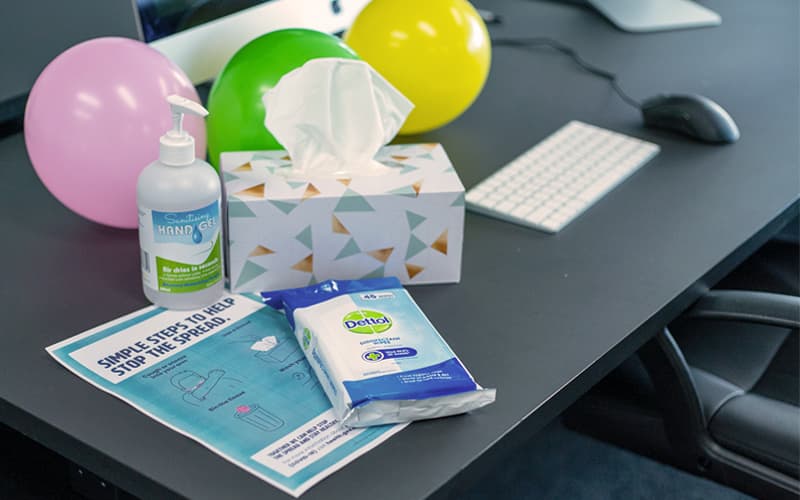The time has come to fling open the disinfected doors and step inside the sanitised building. While it’s great news for the most part, it’s far from business as usual.
Returning to work after a pandemic isn’t easy and not everyone is going to feel okay about it.
Some will be cautious, even anxious, while others will quickly go back to their old ways of invading your personal space and touching everything in sight.
It’s up to everyone to respect the former’s feelings and remind the latter of the new procedures.
We all have the right to a healthy and safe work environment and employers have a legal duty of care to provide this. To help you put the new measures in place, we’ve created a free COVID-19 workplace checklist.
Keep in mind that not everything on our list will be possible for your business, for example if you run a restaurant, you sort of need to let visitors in.
Let’s get into what you can do to keep yourself, your teammates and your customers safe.
If you want to skip the ‘why’ and get straight into the ‘what’, download our free COVID 19 workplace checklist using the form below.
Hygiene
Washing our hands has been ingrained in our brains – just look at the huge spike in Google searches for “hand washing” in March 2020.
We need to keep up this vigilance, so here are a few things you can do to remind employees to keep up good hand hygiene:
- Set up hand sanitiser stations at entry and exit points.
- Place hand sanitiser and tissues in frequently used areas like the kitchen and boardroom.
- Replace tea towels and hand towels with paper towel.
- Stock plenty of hand soap.
- Have disposable gloves at hand.
Face masks are mandatory in most parts of the world, with the rules varying from state-to-state in Australia.
Ensure employees are wearing masks in line with your local regulations. While most people will have their own, keep plenty of masks on site for those ‘just in case’ moments.
RELATED: COVID-19 Health & Safety Services
Cleaning and Disinfecting
When our employees returned to work, it was like all their birthdays had come at once. Except instead of banners, balloons and beers on their desks, they had hand sanitiser, masks, anti-bacterial wipes and tissues. Hooray!
As well as providing these hygiene essentials, you should also:
- Have your cleaners do a “deep clean” before you reopen.
- Provide employees with hand sanitiser, anti-bacterial wipes and tissues.
- Provide paper towel (or disposable cloths) and detergent.
- Inform employees they need to clean their desks and equipment daily, plus personal items like phones, keys and sunglasses.
- Organise frequently touched surfaces to be cleaned every day, e.g. door handles, handrails, the kettle, buttons on lifts etc.
- Communicate that hot-desking is not permitted.
- Inform employees that plates, mugs and cutlery must be washed up immediately or loaded into the dishwasher – no one likes a dish dumper anyway.
Top tip: If you need to disinfect a surface, make sure you clean it first using detergent. A disinfectant will not kill germs if the surface hasn’t been cleaned first.
Physical Distancing
This one is probably the hardest, especially when you work in a small office or you’re reunited with your work bestie…
With restrictions lifting, physical distancing is easy to forget. Posters are a simple way to keep it front of mind, along with the following measures:
- Provide online meeting software – if a meeting can’t be done remotely, limit attendees, choose a large room and keep it short.
- Put up signs to let workers know how many people can use meeting rooms and lifts at once. This number will vary depending on your state government’s rules and the size of your facilities, so it’s up to you to determine a safe capacity.
- Create a roster for employees to work in shifts if necessary.
- Inform employees that only staff can enter the business, and they shouldn’t be going to external meetings.
- Implement contactless deliveries.
- Move workstations, desks and tables in staff rooms further apart.
- Don’t shake hands or touch anything unnecessarily.
- If handling transactions, accept contactless card payments only.
Stay Home
Sometimes the best option for your employees is to continue working from home. Give employees the option to keep working from home if you can, especially if they have a compromised immune system. But make sure they’re set up correctly.
If you or your colleagues start to feel unwell while working from home, it’s crucial you take the following steps:
- Notify your manager immediately
- Stay inside
- Check your symptoms via the Australian Government’s COVID-19 Symptom Checker.
If anyone feels unwell at work, this is where your management plan comes in…
RELATED: Working from Home: Tackling Ergonomics, Isolation and FOMO
Develop a COVID-19 Management Plan
So what if you put all these measures in place and the worst still happens?
It’s a legal requirement of certain businesses to collect contact details from all visitors. If you haven’t already, we recommend downloading a contact registering app such as SafeWA or COVIDSafe, and asking all staff and clients to sign in before entering the premises – even if this isn’t mandatory for your particular business. To set up a unique QR code for your business, download the SafeWA app and follow these instructions.
You should also have a paper register for those who don’t have the app, so click here to access the templates. Just make sure you have somewhere to store the contact details confidentially, and someone responsible for maintaining the register. For more info about contact tracing, head to the WA Government or Australian Government website.
You need to have a COVID-19 management plan ready just in case an employee is suspected or confirmed to have COVID-19. This plan should cover:
- List the steps you’ll take when an employee has been a close contact of the virus or shows symptoms – we recommend following SafeWork Australia’s 6 Steps.
- Document how you’ll support that employee
- Plan how you’ll notify others – both internally and externally
- Document who will cover that employee’s role
- Detail how you’ll make your workplace safe for everyone, i.e. cleaning and disinfecting the office, having staff self-isolate, using a health surveillance team to offer testing.
If your business handles food, be sure to follow the advice of Food Standards Australia New Zealand.
There’s no doubt about it, COVID-19 has truely changed the way we work, but it’s not all bad. There will be less meetings, more flexible work arrangements and people will actually stay home when they’re sick.
It’s going to take a bit of getting used to, but it’s important to be patient and understanding of your most valuable asset: your team.
Need more than a COVID-19 workplace checklist? Explore our COVID-19 services today.



